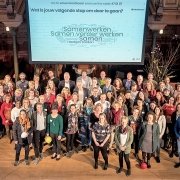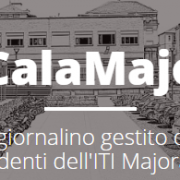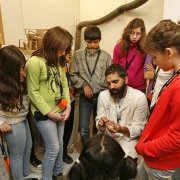Live Grading
Excerpt
Live Grading is an example of curriculum development, which is the brain child of Dr. Leila Pazargadi at Nevada State College, aiming to enhance academic writing skills for all students. This practice is proven to be especially effective for non-traditional and first-generation students. This student-centered initiative entails a teaching practice in which teachers grade papers (essays, papers or assignments) during individual meetings with students. The idea behind this initiative is to enable a mentor-like relationship between students and their teacher, to empower students and enhance academic writing skills.
Narrative, origins and objectives of the initiative
What kind of project is this? Please give a short description (summary) of it.
The Live Grading initiative is a successful grass-roots example of curriculum development within the context of higher education. Assistant professor in English literature at Nevada State College, Dr. Leila Pazargadi, developed Live Grading, the teaching practice at NSC and other faculties that are currently shaping it to their own needs. It has proven to be especially successful for first-generation and non-traditional students. This innovative teaching practice is cost-effective, student-centered and can easily be implemented anywhere and in any context. The basic goal of this practice is to grade a piece (for example a paper, an essay or an assignment) during individual meetings with students. During these 20-30-minute meetings, the teacher reads the piece out loud and discusses and grades the piece on the spot.
This grading practice enables a mentorship between teacher and student. It allows teachers to learn firsthand from students what they intended to say or write, but also ensures a sense of accountability. Students are held accountable for submitting pieces that they worked on and that reflect their efforts and abilities. The teacher is also held accountable for making the student feel at ease, as well as providing constructive feedback that supports the student’s learning process. This practice also supports teachers in the process of getting to know their students, to see if students truly understand their feedback, but also makes it possible to communicate and discuss what they expect from their students. The underlying goal of this practice is to empower students in helping them to find their voice through developing academic writing skills.
Please tell us why, in general, this project is considered a successful one?
The idea behind Live Grading is that teachers organize grading in this innovative way, instead of grading after hours or when they are at home, when the student is not around. Teachers can even use class time to meet up with students in their classrooms or offices. What's more, is that the results are very promising. Students really see and learn where their level of academic writing is at, and they also learn how to specifically approve these skills and think of where they want to go. On average, academic writing levels of students tend to improve between 5 - 10% from their first to second Live Graded piece. Besides that, it is also a very cost-effective initiative that can easily be implemented anywhere and in different (educational) contexts.
And why would you consider it a grass-roots initiative?
Dr. Pazargadi found out that many students don’t fully read, understand and comprehend the notes that are given back to them after it has been marked/graded by the teacher. This initiative is therefore developed at NSC as a necessity. The underlying goal is to truly enhance academic writing skills in a way that works for all students.
What challenges needed to be solved in this project?
A challenge that is important to note here is that power-dynamics are always at play between a teacher and student. Be mindful of that, also in the process of Live Grading. Speaking in terms of ‘we’, helps to diminish this power-dynamic a bit, and it helps to communicate clearly that practicing academic writing is a process that teacher and students are working on together. Live Grading facilitates a mentor-like relationship. It can increase the accountability since students directly see and experience their teacher’s reaction. For example, they see excitement or confusion. This also enables them to really take it seriously, but it might also put pressure on them in the writing process. Therefore, it is important to safeguard the well-being of the students and provide positive yet critical feedback to truly enhance academic writing skills.
Most teachers still grade students’ papers privately in their office, or at home. Then, at a later stage, students are handed their graded papers that often entail some remarks and constructive feedback. Many other teachers consider Live Grading to be both time-consuming as well as draining. It can be heavy for the students as well as for teachers. Therefore, it is advised to incorporate Live Grading into the curriculum, only do it at school, during school hours and plan a maximum of four appointments in the same day.
Other challenges are that students sometimes write as if they are texting, or bi-cultural/bilingual students that might have a strong command of both languages while others might struggle with both. When students are present during Live Grading sessions, reading sentences out loud helps them to understand and really hear the impact of their writing styles.
Is this initiative based on any particular theoretical framework? Which one?
This initiative is not necessarily based on a theoretical framework. However, this teaching practice is developed from the conviction that teaching along a social justice curriculum is important. Therefore, Dr. Pazargadi implemented this practice in all of her NSC courses, and today faculties are shaping it to their own needs. These courses all aim to support students in becoming effective communicators by practicing making arguments.
This intervention connects to a social justice teaching philosophy that aims to centralize student voices. From this philosophy, literature is considered an important platform that empowers students, supports them in discovering their voice and enables them in using that voice. Teachers should model the behavior that they want to see in their students, in that process teachers can be considered more of a mentor or coach. Therefore, it is very important to get to know students, to know where they want to go, to know what they want to become and cultivate that.
(Appendix) Is your intervention standing on its own or is it a part of a bigger and more holistic approach?
Please describe the group(s) intended as beneficiaries of this initiative
Why has this group (have these groups) been chosen?
Most students have mentors in life but not necessarily for the learning process in college. This teaching practice benefits all students but is particularly effective for enhancing academic writing for first-generation as well as non-traditional college students. These students will benefit most from the Live Grading sessions because they more often lack confidence and support. Live Grading supports all students, but is particularly effective for supporting and increasing the confidence of students that are the first in their families to go to higher education, as well as non-traditional students.
Could you please tell us something about the relative size of the (of each) target group, within the school/university population, region and/or country?
About 60% or more of all students that are enrolled at Nevada State College, are first-generation students. Nevada State College started only 15 years ago, so it is a relatively new college with 4500 enrolled students. All students have to follow English language courses since it is a general requirement. Some of the non-traditional students are, for example, parents or grandparents themselves, who study part-time and take classes online.
Which social characteristics are taken into account and what is the geographical area covered?
In the context of Live Grading, social characteristics like mental well-being are also taken into account when they enter the classroom or office. It is important to think what a student needs and can handle, what would be effective and what form of encouragement helps to support students in becoming the best version of themselves. Sometimes it helps to say strategic things like: “I’m with you”, “We can do this”, to prevent them from feeling isolated. If students struggle with anxiety or other mental health issues, it might also be helpful to ask if it works to pre-grade the piece and discuss that feedback with the individual student. The initiative is student-centered with the aim to support all students in a way that suits them best.
On which level is the project implemented?
The project is implemented on classroom level and is an example of curriculum development.
Please describe the political and socio-economic factors that you believe have been important enablers for your initiative
Did the initiative have political support?
The initiative doesn’t necessarily have political support.
How did it fit with local, regional or national policies?
Many students are impacted by (inter)national, regional as well as institutional policies that call for action. As mentioned, the social justice teaching philosophy is built on the expectation that scholars (teachers as well as students) aim to analyse issues that they see in the world together, and think of possible solutions to solve these issues. The role of the teacher is to make sure that they communicate both their expectations as well as their confidence in students.
Who are the stakeholders supporting the initiative?
Dr. Pazargadi presented the practice of Live Grading at the European Access Network event in 2018. Although some teachers at Nevade State College were skeptical, the institution has been very supportive and are shaping it to their own needs.
Are there particular demographic changes present that are influencing the project?
The state of Nevada is on the bottom of the list with regards to quality high school curricula, and many students fail their high school exams while others don’t speak other languages than American-English. Nevada is one of the last Blue Collar states with an economy that thrives on construction and casinos. Many people living in the region still consider high school as enough to get a paying job, so the idea of college is still kind of new.
What is the institutional strategy and culture of the (educational) organization?
Nevada State College is the first state college of Nevada and is not a university yet. Therefore they offer undergraduate (Bachelor) but no graduate (Master) programs. Many students get into Nevada State College on scholarships and are locals. Most of them have felt neglected and left out of the educational system, even before they entered Nevada State College. This context of the organization has been extremely important and underscores the need for initiatives like Live Grading that are developed from a social justice teaching philosophy.
To what extent does the initiative have an influence on institutional policy (or potential influence) of the (educational) organization?
To some extent, the initiative influenced the organization since the institution implemented Live Grading into the summer program. Dr. Pazargadi developed a workshop for her own institution, to explain the benefits of this practice. This resulted in other colleagues developing and implementing Live Grading in their own courses as well.
(Appendix) Is there public support for your initiative and the issue it addresses?
(Appendix) What other factors do you think have been important for the success of this initiative?
Please describe the overall initiative design and the methods and tools used to reach the goals
Please describe the specific activities carried out.
During the course of a semester, students are asked to hand in their first piece during the second week of the course. In some cases, the deadlines vary, and initial Live Grading sessions can be planned for the 4th or 5th week as well. Students are asked to come to the office of the teacher. After the Live Grading session, students are granted a rewriting opportunity with a two-week turnaround. At the end of the semester there is another grading, which is planned voluntarily on the student’s request.
Dr. Pazargadi uses approximately a week of class time to plan in all of the Live Grading sessions with her students. For a two to three-page piece, a 20-minute meeting is generally enough. If the assignment, paper or essay consists of about fifteen to twenty pages, it is important to pre-grade it before the meeting with the student. It is also possible to pre-grade pieces and discuss the feedback in the 20 to 30-minute meetings, as this method allows more time for the teacher and student to rewrite the paper together after it has been graded.
Structure of Live Grading
A developed rubric supports structuring the grading process. Some examples of the distinguished elements that are part of the rubric:
- The marking
- Usage of commas
- Types of sentences
- Methodology
- Structure
- Interpretation
- Command of the English language
- Academic tone
- Argumentation
During the individual meetings with students, the teacher grades the paper based on this rubric.
Mentorship
The idea of this teaching practice is also to get students to step into the office of the teacher. This will enable the teacher’s mandated role as a mentor, to boost comprehension and to develop, communicate and support students in achieving goals that they want to work on throughout the rest of the semester. It is important for the teacher to communicate their expectations of students, to express that they are confident that students can get good or even excellent grades and that they have high expectations. Many first-generation students tend to be anxious at first and are afraid of stepping into the office of the professor. As mentioned, it is very important to be mindful of these power-dynamics.
Some practical tips that help students become more at ease and overcome those fears:
- Making sure the office is warm and inviting.
- Elaborate on the mentor-relationship with the student. Discuss with the student what you will be doing. The teacher will assess the student’s piece in the room to support the understanding of the issues. The goal is to learn from the Live Grading session and improve writing skills.
- Ensure that it is okay to record the session and / or taking notes.
- Speak in terms of trust, appreciation, support and co-creation.
What were the key roles (teacher, student, management team etc.) within the project?
In this initiative, only roles of the students and the teacher are important.
What ideas, tools, theories, models, methodology (etc.) have been used to reach the goals?
As mentioned, the social justice philosophy is an important theory and methodology that is built on the expectation that scholars (teachers as well as students) aim to analyse issues that they see in the world, and think of possible solutions to solve these issues. The role of the teacher is to make sure that they communicate both their expectations as well as their confidence in students. This conviction is central to the Live Grading initiative and contributes to its successes.
What are the final revenues of the project?
Please describe if your project ensured its sustainability
If so, how did you ensure the short-term impact of the project?
The sustainable character of this initiative is directly related to the willingness of the teacher, as well as the time he/she has to invest in the practice of Live Grading. It is important to be mindful of the emotional responses to the student’s different contexts. It may be the student's first time to enter the office of a teacher, so students can be very anxious or nervous. It is important that teachers are mindful of this and react sensibly. In this way, not only students are held accountable to the learning process by submitting an essay that they really worked on hard, but teachers are held accountable for the (delivery of) feedback and contributions to the learning process. Therefore, managing expectations as a teacher and thinking of how to effectively respond to these possible emotional responses are very important before implementing Live Grading into the curriculum.
And how did you ensure the long-term impact of the project?
As mentioned, Dr. Pazargadi developed a workshop for her own institution to explain the benefits of this practice. Since then, some colleagues have developed and implemented Live Grading in their own courses as well. This shows that it has the potential to become integrated in the institution as an assessment tool.
Has your project been replicated elsewhere?
Some other faculties have also implemented Live Grading into their curricula.
Please tell us about the resources used in this initiative
What was the budget for the initiative?
Live Grading is a very good example of a cost-effective initiative that can be duplicated anywhere, at any place and in any context. The only important requirements are:
- That the teacher and pupil/student are both present;
- That they bring a printed paper/essay/assignment that needs to be graded.
A developed rubric can structure the grading process and invite students to the teacher’s office helps. However, this is not necessarily mandatory. It might even be possible to invite students somewhere else, in the case that a teacher doesn’t have a private office. However, it is recommended to use an office if the teacher has one.
How much did the initiative depend on volunteers?
Not at all, since it is an example of an initiative that has been developed for teachers within the context of classes and can take place within the classroom.
How were the costs perceived by the public/the sector/other stakeholders?
Since costs were very low, this was not an issue.
To what extent did the initiative achieve its objectives?
Please describe the evidence to support the success of your initiative.
Out of a class of 20 students, only 3 students use the rewriting option during the first grading opportunity. After that, many students already work out many of the issues between the first and the last grading opportunities.
Did the intervention lead to any unintended (positive) outcomes?
In 75% of the cases students come in voluntarily for a Live Grading session at the end of the semester. This shows that this small intervention has a great impact on students since they really understand and value the approach.
What indicators (quantitative and qualitative) have you measured to demonstrate success?
Student academic writing skills at the start and at the end are measured, which demonstrate the success.




 Interkulturelles Mentoring
Interkulturelles Mentoring



